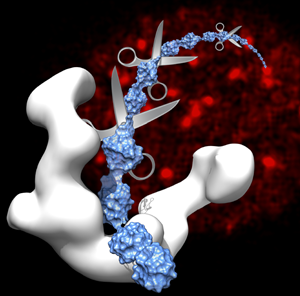Scientists uncover the structure of a protein complex linked with breast and ovarian cancer risk

Scientists at the Francis Crick Institute have described the molecular structure of a key tumour suppressor protein and provided insights into its role in cells.
BRCA1 is a human gene which produces the tumour suppressor protein of the same name. Mutations in BRCA1 can result in a 65-75% lifetime probability of developing breast cancer, and members of families at high risk of breast cancer can be screened for mutations in the BRCA1 and related BRCA2 genes.
The BRCA1 protein has a key protective role in DNA repair and so helps to maintain genetic stability.
Mutations in the BRCA1 gene which result in insufficient or defective production of the BRCA1 protein will inhibit DNA repair and lead to genetic instability. This genetic instability increases the likelihood of cancer-causing mutations.
The BRCA1 protein functions in interaction with three protein complexes (BRCA1-A, BRCA1-B and BRCA1-C).
Scientists at the Francis Crick Institute have described the molecular structure of BRCA1-A and provided insights into its role in deubiquitination, an essential process involved in modulating DNA repair.
The scientists used a range of cutting-edge techniques, including electron microscopy, mass spectrometry and biochemical analysis. Electron microscopy was used to define the overall shape of the protein complex, but this was not sufficient to pin-point the exact locations of the individual molecular components.
A combination of native mass spectrometry and biochemical analysis was then used to provide the extra information required to triangulate the location of the components.
In the longer term, it is hoped that a more detailed understanding of the structure and function of the complex might inform efforts to develop inhibitors of the BRCA1-A and linked complexes which might be clinically useful.
Steve Smerdon, Group Leader at the Francis Crick and final author on the paper, said: "The structure, albeit at low resolution, is really the first structural glimpse of any of the major BRCA1 complexes. In a way, the size and complexity is somewhat surprising since the reaction it catalyses is relatively simple: the cleavage of a single bond between two linked ubiquitins. The structure now suggests how the overall architecture might act to stabilise interactions with ubiquitin chains. More importantly it also indicates how interaction with BRCA1 itself might regulate its activity."
The paper, Three-dimensional architecture of the human BRCA1-A histone deubiquitinase core complex, is published in Cell Reports.
More information: Otto J.P. Kyrieleis et al. Three-Dimensional Architecture of the Human BRCA1-A Histone Deubiquitinase Core Complex, Cell Reports (2016). DOI: 10.1016/j.celrep.2016.11.063
















